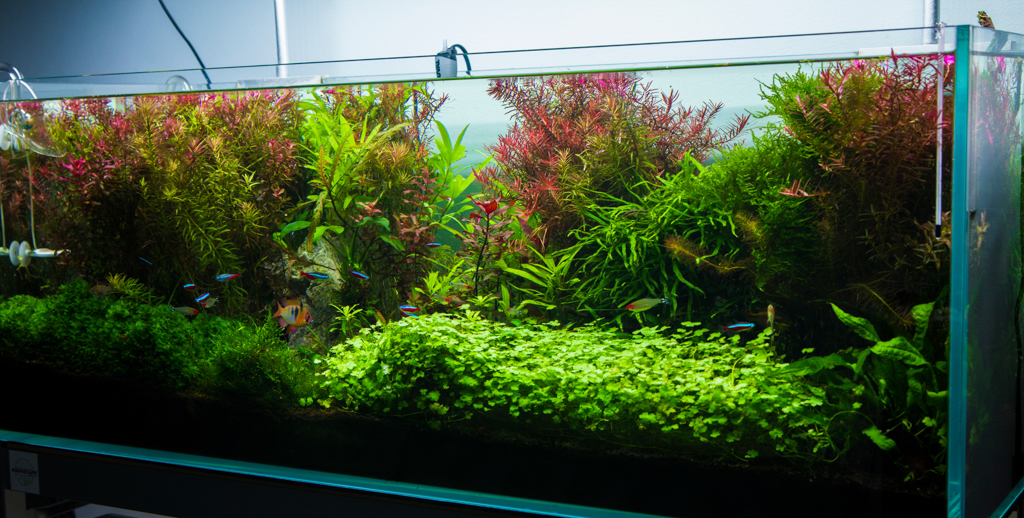Aquariums are a popular way to bring a bit of the ocean into your home or office. While simple aquariums with minimal equipment and technology can be beautiful and enjoyable, high-tech aquariums are becoming increasingly popular among experienced aquarists. These advanced aquariums use sophisticated equipment and technology to create a highly controlled and optimized environment for aquatic plants and fish.
In this article, we will take a closer look at what a high-tech aquarium is, what makes them different from traditional aquariums, and the various components and technologies that are typically used in these advanced systems.
What is a high-tech aquarium?
A high-tech aquarium, also known as a high-tech planted aquarium, is an aquarium that utilizes advanced technology and equipment to create a highly optimized and controlled environment for aquatic plants and fish. These aquariums are typically designed for experienced aquarists who are interested in creating a highly customized and advanced ecosystem.
The goal of a high-tech aquarium is to create a highly optimized and controlled environment that allows aquatic plants and fish to thrive. These aquariums can be challenging to set up and maintain, but they can also be incredibly rewarding for experienced aquarists who are interested in pushing the limits of what is possible in an aquarium.
What makes a high-tech aquarium different?
Compared to traditional aquariums, high-tech aquariums are designed to provide a highly controlled and optimized environment for aquatic plants and fish. They typically use advanced technology and equipment to create this environment, including specialized lighting, CO2 injection systems, advanced filtration, and nutrient dosing systems.
High-tech aquariums are also typically designed to provide a highly aesthetic and visually appealing environment. They often use aquascaping techniques, which involve arranging plants, rocks, and other materials to create a visually pleasing underwater landscape.
Components of a high-tech aquarium
There are several key components and technologies that are typically used in high-tech aquariums:
- Lighting: High-tech aquariums often use specialized lighting systems that are designed to provide the specific light spectrum and intensity needed for photosynthesis in aquatic plants. LED lights are a popular choice because they are energy-efficient and provide a high-quality spectrum of light.
- CO2 Injection: Carbon dioxide (CO2) is an essential nutrient for aquatic plants, and high-tech aquariums often use CO2 injection systems to ensure that plants have access to this vital nutrient. These systems typically use a pressurized CO2 canister and a diffuser to distribute the CO2 throughout the aquarium.
- Filtration: High-tech aquariums often use advanced filtration systems that are designed to remove waste and impurities from the water while also providing a high level of water circulation. These systems may include mechanical, biological, and chemical filtration components.
- Fertilization: In addition to CO2, aquatic plants require a variety of nutrients to grow and thrive. High-tech aquariums often use specialized fertilizers and nutrient dosing systems to ensure that plants have access to the necessary nutrients.
- Monitoring and Control Systems: High-tech aquariums often include sophisticated monitoring and control systems that allow the aquarist to closely monitor and control various parameters, such as water temperature, pH, and lighting intensity.
Aquascaping in high-tech aquariums
One of the most visually striking aspects of high-tech aquariums is aquascaping. Aquascaping involves arranging plants, rocks, and other materials to create a visually pleasing underwater landscape. Aquascaping in high-tech aquariums is typically more elaborate and complex than in traditional aquariums, and may involve creating a natural-looking reef or underwater landscape.
Benefits of a high-tech aquarium
There are several benefits to owning a high-tech aquarium:
- Aesthetics: High-tech aquariums can be incredibly beautiful and visually striking. They can be customized to create a wide range of underwater landscapes, from natural-looking reefs to futuristic and abstract designs.
- Plant Growth: High-tech aquariums provide the ideal environment for aquatic plant growth. With the use of specialized lighting, CO2 injection, and nutrient dosing, plants can grow faster and healthier than in traditional aquariums.
- Fish Health: A well-maintained high-tech aquarium can provide a healthier environment for fish. Advanced filtration systems and water quality monitoring help to maintain optimal water conditions, reducing the risk of disease and stress in fish.
- Education and Science: High-tech aquariums can be used for educational purposes, providing a way to observe and study aquatic life up close. They can also be used for scientific research, particularly in the fields of aquaculture and aquatic plant cultivation.
Challenges of a high-tech aquarium
While high-tech aquariums offer many benefits, they can also be challenging to set up and maintain. Here are some of the challenges associated with high-tech aquariums:
- Complexity: High-tech aquariums are more complex than traditional aquariums, requiring more specialized knowledge and equipment to set up and maintain.
- Cost: High-tech aquariums can be expensive, with advanced equipment and technology often costing more than traditional aquarium equipment.
- Maintenance: High-tech aquariums require more maintenance than traditional aquariums. Advanced filtration systems and nutrient dosing require frequent monitoring and adjustment, and the equipment must be regularly cleaned and maintained.
- Time commitment: Setting up and maintaining a high-tech aquarium can be time-consuming, particularly during the initial setup phase.
In conclusion, high-tech aquariums offer an opportunity for experienced aquarists to create a highly optimized and controlled environment for aquatic plants and fish. These advanced aquariums require specialized equipment and technology, and they can be more challenging to set up and maintain than traditional aquariums. However, the benefits of a high-tech aquarium include increased plant growth, healthier fish, and a beautiful and visually striking underwater landscape.
![]()




